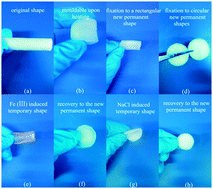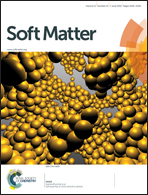Dual-responsive shape memory hydrogels with novel thermoplasticity based on a hydrophobically modified polyampholyte†
Abstract
Shape memory hydrogels offer the ability to recover their permanent shape from temporarily trapped shapes without application of external forces. Here, we report a novel dual-responsive shape memory hydrogel with characteristic thermoplasticity. The water-insoluble hydrogel is prepared by simple ternary copolymerization of acrylamide (AM) and acrylic acid (AA) with low amounts of a cationic surfmer, in the absence of organic crosslinkers. Through either ionic/complex binding of carboxyl groups via trivalent cations or salt-dependent hydrophobic association, the hydrogel can memorize a temporary shape successfully, which recovers its permanent form in the presence of a reducing agent or deionized water. Besides, the unique thermoplasticity of the hydrophobic polyampholyte hydrogel allows the change of its permanent shape upon heating and the fixation after cooling, which is in strong contrast to the conventional chemically cross-linked shape memory hydrogels. This fascinating feature undoubtedly enriches the shape memory hydrogel systems. Thus, we believe that the facile strategy could provide new opportunities with regard to the design and practical application of stimulus-responsive hydrogel systems.


 Please wait while we load your content...
Please wait while we load your content...